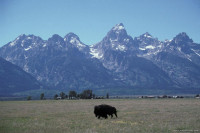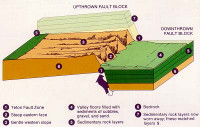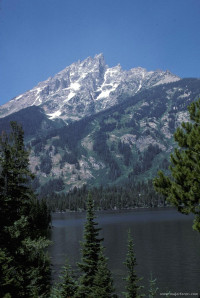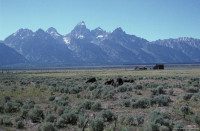|


Grand Tetons with buffalo in foreground.

Diagram of the fault block system that illustrates how the Grand Teton Range developed.






Grand Teton National Park owes its’ name to the largest mountain in the range – Grand Teton. The name derives from the French trapper name given in the 19th century: “les trois Tetons” which means the three breasts (related to the three largest peaks in the range). The region was established as a park when President Calvin Coolidge signed the legislation on February 26, 1929.
Paleo Indians (Clovis culture) lived in the region for at least 11,000 years. The Shoshone tribes were the Native Americans that subsisted in the Grand Teton area when John Colter, a member of the Lewis and Clark expedition, arrived as the first European to see the Grand Tetons. He was hired in 1807 and 1808 to explore the Yellowstone and Teton region for the development of fur trapping.
The youngest part of the Rocky Mountains, the Grand Teton range, began forming (uplift) about 9 million years ago. The range is on the western flank of a block that straddles a north-south trending fault and has moved up relative to the eastern block where Jackson Hole and the plains sit. This is the reason for the extreme relief in the region – Grand Teton is 13,775 ft (4,199 m) above sea level and is more than a mile higher than the base of the range along Jackson and Jenny Lakes. Most of the erosion that has occurred along the Grand Teton range has taken place due to glaciation beginning as far back as 250,000 years ago.

Grand Teton National Park is a United States National Park in northwestern Wyoming. Approximately 310,000 acres (130,000 ha) in size, the park includes the major peaks of the 40-mile (64 km) long Teton Range as well as most of the northern sections of the valley known as Jackson Hole. Only 10 miles (16 km) south of Yellowstone National Park, the two parks are connected by the National Park Service managed John D. Rockefeller, Jr. Memorial Parkway. These three protected areas in conjunction with surrounding National Forests constitute the Greater Yellowstone Ecosystem, which at almost 18,000,000 acres (7,300,000 ha), is one of the largest intact mid-latitude temperate ecosystems in the world.






 Please share your ideas with us.
Please share your ideas with us.